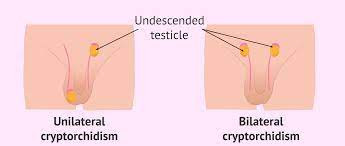Definisi
Testis ektopik adalah penyakit bawaan lahir langka yang terjadi pada anak laki-laki. Testis ektopik terjadi ketika testis atau buah zakar tidak turun ke dalam kantung skrotum, melainkan berhenti di tempat yang tidak seharusnya di dalam tubuh. Pada kondisi normal, testis akan turun ke kantung skrotum sebelum dan setelah bayi lahir. Penurunan testis terjadi selama masa kehamilan dan sudah terdapat jalur normal yang dilalui testis untuk turun menuju kantung skrotum.
Testis ektopik sedikit berbeda dengan penyakit kriptorkidisme atau tidak turunnya testis ke dalam kantung sktrotum. Jalur turun testis ke dalam kantung skrotum sudah ada dan biasanya testis tersangkut di salah satu titik penurunan. Sementara, pada kasus testis ektopik, testis berjalan melenceng dari jalur normal dan berhenti di satu tempat dalam tubuh. Lokasi paling sering dari testis ektopik adalah di rongga perut, area pubis atau panggul, selangkangan, dan paha atas. Posisi testis biasanya tidak normal dan perlu pemeriksaan lebih lanjut untuk mencari lokasi testis. Kondisi ini membutuhkan penanganan segera karena memiliki risiko komplikasi yang berat dalam jangka waktu lama.
Penyakit ini sangat langka, jumlah kasusnya sekitar 5-10% dari kondisi testis yang berada di luar skrotum. Penting untuk mengenali testis ektopik sedini mungkin karena jenis terapinya berbeda dari penyakit tidak turunnya testis.
Penyebab
Testis ektopik termasuk salah satu kelainan pembentukan genital dan terjadi pada anak laki-laki. Terdapat suatu sindrom bernama sindrom malformasi kongenital yang ditandai dengan ketidaksempurnaan pembentukan organ janin di masa kehamilan. Testis ektopik masih belum diketahui secara jelas penyebab utamanya.
Meski begitu, terdapat pendapat yang menyatakan adanya hubungan antara kelainan sistem endokrin (sistem tubuh yang melepas hormon untuk mengatur beragam fungsi tubuh) selama masa kehamilan dengan angka kejadian testis ektopik pada bayi yang dilahirkan. Tingkat kesembuhan testis ektopik ini tergantung seberapa jauh penyimpangan posisi testis dan jumlah testis yang mengalami kelainan. Kondisi ini dapat terjadi pada salah satu testis atau keduanya.
Faktor Risiko
Faktor-faktor yang dapat meningkatkan risiko terjadinya testis ektopik pada anak antara lain:
- Bayi laki-laki yang lahir prematur
- Bayi laki-laki dengan berat badan lahir rendah
- Adanya kelainan genetik
- Riwayat penyakit serupa atau yang berkaitan dengan tidak turunnya testis di keluarga
Gejala
Gejala testis ektopik sebenarnya cukup khas bila dibandingkan dengan kondisi serupa. Tanda yang pasti disadari adalah tidak adanya testis pada salah satu atau kedua kantung skrotum. Kondisi ini dapat langsung disadari saat bayi baru lahir karena dokter anak akan melakukan pemeriksaan awal untuk memastikan semua anggota tubuh lengkap. Testis tidak teraba dapat terjadi pada beberapa kasus selain testis ektopik seperti testis retraktil (testis berpindah tempat keluar dari kantung skrotum ke selangkangan), testis yang tidak turun, serta tidak terbentuknya testis.
Gejala kedua adalah teraba benjolan di bagian tubuh lain (selain skrotum) atau bahkan tidak teraba benjolan testis sama sekali. Ini adalah kondisi yang membedakan dengan kasus lain. Pada testis ektopik, testis lebih sering tidak teraba. Kalaupun teraba biasanya ada di posisi yang tidak normal seperti di bagian perut, atau justru di dekat selangkangan dan paha bagian atas. Biasanya tidak ada gejala tambahan lain karena bayi yang mengalami testis ektopik harus segera dilakukan ditangani sebelum anak berusia satu tahun.
Diagnosis
Testis ektopik dapat didiagnosis pada pemeriksaan fisik yang dilakukan oleh dokter anak. Untuk memastikan penyakit yang dialami adalah testis ektopik, dokter akan melakukan pemeriksaan lanjutan. Dokter spesialis anak akan menilai bayi yang baru lahir dan salah satu pemeriksaan yang wajib dilakukan pada bayi laki-laki adalah memeriksa kedua skrotum dan memastikan lokasi atau posisi testis. Pada tahun pertama kehidupan bayi, dapat dilakukan pemeriksaan lagi untuk memastikan testis sudah kembali ke lokasi yang seharusnya atau belum.
Pemeriksaan lanjutan yang dapat dilakukan dokter adalah pemeriksaan USG. Dengan menggunakan USG, dokter dapat memastikan kantung skrotum kosong dan mencari lokasi testis di jalur normal. Testis terlihat berbentuk oval di bawah mesin USG dan biasanya justru terlihat di lokasi-lokasi lain di tubuh. Selain USG, dokter dapat menyarankan pemeriksaan MRI untuk memastikan lebih jelas lokasi testis. Begitu diagnosis tegak, biasanya tata laksana segera dilakukan, apalagi bila usia anak di bawah 1 tahun.
Tata Laksana
Tata laksana testis ektopik adalah prosedur pembedahan untuk memindahkan testis kembali ke kantung skrotum. Operasi terbuka yang dilakukan bernama orchiopexy dan dilakukan oleh dokter bedah atau dokter bedah anak. Dokter juga dapat melakukan tindakan operasi laparoskopi atau pembedahan perut untuk memindahkan testis ke skrotum.
Testis ektopik diharapkan dapat kembali ke tempat normalnya pada tahun pertama kehidupan. Ketika anak menginjak usia 1 tahun, dokter anak akan memeriksa bayi untuk memastikan lokasi testis sudah normal atau tidak. Bila testis teraba di jalur normal, meskipun belum ada di posisi yang tepat, itu tidak menjadi masalah karena testis akan turun dan berada ke kantung skrotum pada masa pubertas. Tapi testis dapat tidak teraba karena berada di lokasi yang lebih dalam, seperti misalnya di rongga perut.
Waktu terbaik untuk operasi bervariasi, tergantung dengan lokasi ditemukannya testis serta usia anak saat itu. Umumnya tindakan operasi dilakukan saat anak berusia 3 - 6 bulan dan tidak berusia di atas 1 tahun. Setelah operasi, dokter juga akan tetap melakukan pemantauan jangka panjang karena anak berisiko tinggi mengalami ketidaksuburan dan keganasan seperti kanker.
Komplikasi
Komplikasi testis ektopik berkaitan dengan beberapa aspek. Salah satu aspek yang menonjol adalah kesuburan karena testis berfungsi sebagai tempat pembuatan sel sperma. Pada beberapa kasus testis yang posisinya tidak normal dan tidak ditangani dengan baik, akan menimbulkan masalah yang serius di kemudian hari. Beberapa masalah yang bisa terjadi meliputi:
- Masalah kesuburan atau menjadi tidak subur di masa depan
- Risiko cedera atau trauma meningkat
- Risiko puntiran testis
- Risiko keganasan atau kanker
Pencegahan
Tidak ada pencegahan yang efektif untuk mencegah testis ektopik. Perkembangan testis terjadi selama masa kehamilan dan setelah lahir belum tentu testis sudah berada di posisi yang sesuai. Maka dari itu, perlu diperhatikan kesehatan selama masa kehamilan hingga waktunya persalinan nanti. Beberapa poin yang dapat diingat sebagai pencegahan adalah:
- Jaga kesehatan selama masa kehamilan
- Makan makanan bergizi
- Jangan merokok atau minum alkohol saat hamil
- Lakukan pemeriksaan rutin ke dokter, sebaiknya USG sesuai anjuran
Kapan Harus ke Dokter?
Anda harus segera membawa anak Anda ke dokter bila merasakan gejala di atas. Skrotum yang kosong selama 1 tahun pertama kehidupan anak merupakan tanda yang harus diwaspadai dan ditanyakan ketika waktunya membawa anak Anda kontrol ke dokter. Bicarakan rencana kedepannya dengan dokter Anda, terutama berkaitan dengan operasi. Agar testis ektopik dapat ditangani dengan baik dan cepat.
Mau tahu informasi seputar penyakit lainnya? Cek di sini, ya!
- dr Hanifa Rahma
Ectopic testes: what is it, symptoms and treatment | Top Doctors. Top Doctors. (2022). Retrieved 1 July 2022, from https://www.topdoctors.co.uk/medical-dictionary/ectopic-testes#.
Khader.O.Thabet, M. (2020). Ectopic testis | Radiology Reference Article | Radiopaedia.org. Radiopaedia.org. Retrieved 1 July 2022, from https://radiopaedia.org/articles/ectopic-testis.
Gadelkareem, R., Shahat, A., Reda, A., Moeen, A., Abdelhafez, M., & Abughanima, M. et al. (2020). Ectopic testis: an experience of a tertiary-level urology center at Upper Egypt. Annals Of Pediatric Surgery, 16(1). https://doi.org/10.1186/s43159-020-00038-8
Lopes Vieira, J., Brahme, G., Pandya, N., & Desai, A. (2013). Empty scrotum: undescended testis or ectopic?. Case Reports, 2013(aug08 1), bcr2013009152-bcr2013009152. https://doi.org/10.1136/bcr-2013-009152
Undescended testicle - Symptoms and causes. Mayo Clinic. (2022). Retrieved 1 July 2022, from https://www.mayoclinic.org/diseases-conditions/undescended-testicle/symptoms-causes/syc-20351995.












